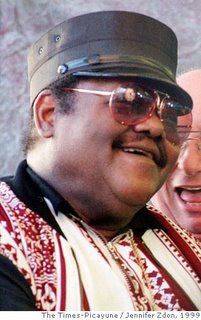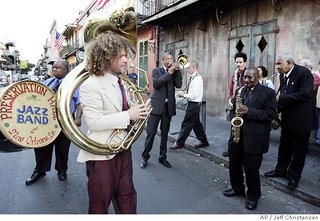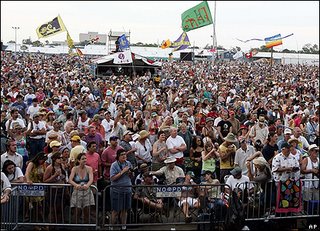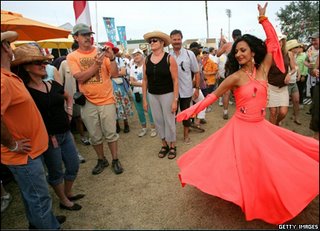
L ondres. 27 de abril (BBCmundo).- Con un despliegue que incluye a los cantantes y músicos más representativos de las últimas décadas empezó el Festival de Jazz de Nueva Orleans, Estados Unidos, el primero desde que el huracán Katrina azotara la histórica ciudad en agosto de 2005.
Dividido en dos fines de semana, el evento es parte de un esfuerzo por recuperar el alma musical de una ciudad que fue prácticamente destruida por el fenómeno natural.
Más de 4.000 artistas participan este año en el evento. Entre ellos, Bob Dylan, Bruce Springsteen, Elvis Costelo, Paul Simon y Lionel Richie.
Un portavoz del festival declaró que es "un momento muy importante para apoyar a Nueva Orleans".
Normalmente, cada año el festival atraía a unas 400.000 personas y generaba unos ingresos de cerca de US$300 millones.
Fats Domino
Uno de los hijos de la ciudad, Fats Domino, el cantante, painista y compositor que se creyó había muerto durante la tormenta, también estará presente.
El artista, cuyos discos de música R&B dominaron las carteleras musicales y las ventas de finales de los años 50 y 60, vivía en una de la zonas más pobres de Nueva Orleans, el Barrio 9, que fue el más afectado cuando Katrina asoló la ciudad.
Su momentánea desaparición llevó a una ansiosa búsqueda por parte de su familia y la prensa, hasta que fue hallado, cuatro días después, entre las personas que habían sido rescatadas.
El huracán mató a 1.300 personas y destruyó gran parte de la herencia histórica de la ciudad, de origen francés.
Los seguidores del festival que no asistan al evento podrán verlo a través de internet, con cobertura en vivo desde los 10 escenarios ahí instalados.
Jazz festival braves the storm in shattered New Orleans
Joel Selvin, Chronicle Senior Pop Music Critic

Fats Domino headlines at JazzFest. The Times-Picayune file photo by Jennifer Zdon via Associated Press
N ew Orleans. Thu, Apr. 27, 2006 (San Francisco Chronicle) -- Fats Domino is all but retired these days, but the one date he always says yes to is the New Orleans Jazz and Heritage Festival, opening today at the Louisiana Fair Grounds. His presence is especially important this year. Not only was the '50s rock star chosen to grace the poster for this year's festival, but he will headline the final concert of the event that almost didn't happen.
The 78-year-old Domino, who went missing for a few days after Hurricane Katrina devastated the Crescent City last summer, represents not only the city's musical heritage but its hopes for recovery as well.
The music giant, known for such classics as "Blueberry Hill," "Ain't That a Shame" and "Walking to New Orleans," built his big pink-roofed mansion in the city's Ninth Ward. After the hurricane, photos of him being rescued from the roof of his house flashed around the world. Today, attached to the fence of his empty, ruined house is a sign of quiet defiance: "No Bulldozing." Fats is in New Orleans to stay.

Fats Domino's home in the Ninth Ward of New Orleans -- he has posted a sign showing his intention to stay put. Photo by Lori Waselchuk, special to the Chronicle
And so is JazzFest. With rock stars such as Bruce Springsteen, Bob Dylan, Elvis Costello, Paul Simon, Jimmy Buffett and Dave Matthews set to appear, in addition to most of the great rhythm and blues, jazz and Cajun musicians from the region, New Orleans looks to this year's JazzFest to be a turning point in the city's recovery.
"When the machine clunks to life this weekend," said festival producer/director Quint Davis, "we'll find out if there are any missing teeth in the gears."
Since its humble beginnings in Congo Square in 1970, JazzFest has grown into an international event and, for New Orleans, a spring civic ritual that surpasses even Mardi Gras. Not only does the $10 million festival pump about $280 million into the city's economy, but, unlike Mardi Gras, it is an event that people who live in New Orleans actually like and attend.
As politicians squabble over how long it is taking to rebuild, a good portion of the population still is unable to return to the city, and a hotly contested mayoral race is headed for a runoff.
This year's JazzFest is a welcome rallying point for the beleaguered community. Since half the festival audience comes from out of town, the event has been a traditional high point for the city's No. 1 industry, tourism. Before Aug. 29, when the levees breached and floodwalls collapsed, swamping more than 80 percent of the metropolitan area, tourism added about $5.5 billion to the city's economy every year.
In 2005, the festival drew 400,000 people, but this year, with the tourist trade all but nonexistent, Davis is understandably worried about attendance.
"That's the $64,000 question," he said, but he added that advance sales are about two-thirds of past years' totals.
Even with diminished expectations of attendance, the city is only barely ready for the event. Storefronts are still boarded up all along Canal Street, the city's main boulevard that divides downtown and the French Quarter. Three of the major hotels -- the Fairmont, the Ritz-Carlton and the Hyatt Regency -- are closed, and others are operating with only some floors open. Many of the city's best-loved restaurants are either still closed or gone for good. Bourbon Street is deserted by midnight. Taxis are scarce. Dixie Beer hasn't resumed production, and the best freshwater crawdads have been driven out of the reach of trappers by saltwater intrusion.
New Orleans is still operating without basic services. Only one hospital is open, and public schools never reopened. The city can't even figure out how to collect property taxes. Entire neighborhoods remain without electricity. Entire ZIP codes are empty, uninhabited, their eerie, ghostly streets littered with debris. Only an occasional car is left, except in the crowded impromptu dumping grounds under freeway overpasses, and many vacant houses aren't even boarded up. Doors have been left open for months. On the front walls of the houses are the telltale marks painted by rescue workers checking the homes for the dead. Two bodies were discovered only last week, and more are expected to be found. Around town, a brown "bathtub ring" on buildings shows the high-water mark, usually somewhere between knee and eye level.
The flood's fury was spent equally on wealthy Lakeview, where homes worth millions often were insured for only $250,000 of flood damage, and the poor black neighborhood on the other side of the Industrial Canal, the Ninth Ward, where Domino grew up and built his home after he hit the big time, when rock 'n' roll was young.
The city has a million heartbreak stories. But the return of this thriving, full-scale JazzFest, which stands to make an important contribution at this crucial stage to the city's recovery, never would have happened without powerful financial support from heavy-hitters. Shell Oil, which already bought about $32 million worth of post-Katrina New Orleans commercial property to house employees after deciding to relocate the company's U.S. headquarters to the city, signed up to sponsor the expensive undertaking for the next two years.
Churchill Downs Inc., owners of the Louisville track that is home to the Kentucky Derby, bought the Fair Grounds, the festival's site for the past 32 years, out of bankruptcy several months before last year's festival. The storm put the decrepit 19th century racetrack, one of the oldest in the country, under water and destroyed the electrical system, the grandstand roof and sides, almost all of the barns, every blade of grass. The new owners made repairs the previous owners never could have afforded.

Quint Davis, producer of the New Orleans Jazz and Heritage Festival, has his fingers crossed. Photo by Lori Waselchuk, special to the Chronicle
JazzFest producer/director Davis was in New York City, watching helplessly on a hotel room TV, when Katrina unleashed her fury on his city. He quickly organized a Sept. 20 benefit at Madison Square Garden. He found 63 New Orleans musicians -- singer Irma Thomas was living in a parking lot at the Baton Rouge airport -- and added such performers as Simon, Matthews, Buffett and Costello, who would become the genesis of this year's festival bill.
Davis announced this year's festival lineup on Nov. 1 without knowing whether he could hold it in New Orleans. Various alternative sites were considered -- Lafayette, La.; Houston; Central Park in New York City. At the beginning of the year, he had yet to book his first act.
"I have 2,000 gospel singers and 35 Mardi Gras Indian tribes," Davis said. "You can't just call an agent and order them up."

The Preservation Hall Jazz Band gathers on a street in New Orleans to mark the first concert at the band's jazz hall since Katrina. Associated Press photo by Jeff Christensen
On 10 stages arrayed over the infield to the large horse-racing track, several hundred performers will appear in six daylong concerts over the next two weeks. In past years, crowds have kept the party rolling until dawn in local restaurants, bars and clubs. This year, fewer places are open, but the partying is likely to continue.
Even though his festival has staggered to its feet only through a concerted effort by powerful influences interested in the city's recovery, Davis does not want to be held responsible for being the turning point in the rebuilding of a city that was abandoned by the NFL, the NBA and the Sugar Bowl.
"A major American city is lying in ruins," Davis said. "Where else would nobody care and not do anything? Whatever's going to happen here is not going to happen fast. The size and scope of the devastation ... it's not going to just take years to do, it's going to take years to know what to do."
New Orleans residents hope jazz festival provides signs of rebirth
BY DAN DELUCA
Knight Ridder Newspapers
NEW ORLEANS - Outside a boarded-up Foot Locker on the edge of the French Quarter, a joyful noise is being made by a teenage brass band whose name - To Be Continued - hangs like a question mark in the air.
Their song is the gospel hymn "I'll Fly Away," jazzed-up, New Orleans-style, full of promise that the worst is over and good times lie ahead.
Residents of this storm-ravaged birthplace of jazz - and wellspring of American popular music - cling to the belief that their city's cultural lifeblood, its very identity, has not been lost. And, despite all they've been through, that the bon temps will once again roulez.
Their hopes will be put to the test Friday, at the start of the 37th - and most significant - New Orleans Jazz & Heritage Festival.
"It's important economically, and therapeutically," says R&B singer Irma Thomas, a Hurricane Katrina evacuee now living in Gonzales, La.
"Even though there's lot of pros and cons as far as the government" - get ready for a politicized JazzFest, amid a contentious mayoral race - "it's important to show the world that there's a reason to come back. It's showing that the city is not giving up on its culture."
The festival runs through Sunday and again next weekend at the rehabbed Fairgrounds racetrack, where workers were busy Thursday with last-minute hammering.
With a big-name line-up whose first weekend alone includes Bruce Springsteen, Bob Dylan, Herbie Hancock, the Meters, Ani DiFranco, and Juvenile - the token New Orleans gangsta rapper - the fest aims to jump-start New Orleans' staggered tourism industry.
Last year, JazzFest drew more than 400,000 people, and pumped $285 million into local businesses, according to Angele Davis, of Louisiana's department of Culture and Recreation. But since Katrina, says JazzFest producer Quint Davis, the city is losing $15 million in tourism dollars a day.
The festival was in limbo until January, when Shell Oil ponied up sponsorship money, helping meet the needs of JazzFest, many of whose regulars - local Mardi Gras Indians, zydeco accordionists, swamp rockers and Dixieland jazz outfits - have been spread hither and yon by Katrina and Rita.
This year, 100,000 advance tickets have been sold, about the same as last year, said promotions director Matthew Goldman. He said the festival is traditionally is a walk-up business, and organizers are "very optimistic" it will be a banner year.
But in a city whose pre-Katrina population of 450,000 is now less than half that, nobody knows how many people will show. Although some musicians, like trumpeter Kermit Ruffins and songwriter Allen Toussaint, have moved back, others have not and have no plans to.
"It freaked me out when I went back for Mardi Gras, because it used to be 65 percent black and 35 percent white, and now it's the opposite," Ivan Neville, of the Big Easy's first family of funk, told The Dallas Morning News. Neville, now living in Austin, Texas, said, "I just can't see going back for a long time."
Davis' aim is to show that "some semblance of normalcy" has returned. The tourism boosters' claims that the hospitality industry is 90 percent back appear borne out if a traveler sticks to the guide book. Walking through the French Quarter, you'd never know a cataclysm had hit.
That is, if not for the shops selling the T-shirts "Make Levees: Not War" and "Willie Nagin and the Chocolate Factory: Semi-Sweet and A Little Nuts," referring to Mayor Ray Nagin's remark that New Orleans will be a "chocolate city."
But take a right off St. Charles, where the street car named Desire isn't running, on what locals call "the devastation tour" into the Broadmoor neighborhood. Block after block of homes destroyed by fire and water sit crumbling on abandoned streets.
There are plenty of efforts to help displaced musicians, like TipitinasFoundation.org. Habitat for Humanity broke ground this week on a Musicians Village in the Ninth Ward. But if, as jazz patriarch Ellis Marsalis says, "music bubbles up from the streets" here, what happens when the streets are deserted?
"It's just phenomenal the Third World treatment they've gotten from the federal government," said singer and pianist Dr. John, the New Orleans native who was born Mac Rebennack. "This city is the country's greatest ambassador to the world with its music."
He fears that if developers turn it into a "shuck-ass Disneyland, it ain't going to survive. The politicians just want to push it into something they can make more money on. They don't give a damn about these people."
For many New Orleans musicians, business has been good on the road but hurting at home - if they have one. "After the hurricane, a lot of people had New Orleans on their mind," Bennie Pete, tuba player for the Hot 8 Brass Band, said before a gig at Tipitina's on Wednesday. "We got a lot of bookings."
But keeping the band together has been a trial. Pete's family lost its home in the Ninth Ward so he has been living in nearby Kenner. Other band members are as far-flung as Houston, Atlanta and New York.
"They say they want to rebuild the city, but do they want to rebuild it for us?" said the bandleader. JazzFest, he said, promises exposure to a wider audience, but "other than that, it's just another gig."
Even if JazzFest isn't about to make New Orleans' problems disappear, music fans hope that it's a start.
"New Orleans is the soul of the country," says Mark Adler, of Wynnewood, Pa., who has gone to JazzFest with his wife, Alice, for the past 18 years. "We feel it's important to support the city, and it's music."
The strength of that connection makes New Orleanians, like Scott Aiges, who promotes music for the state of Louisiana, think that the crowds will be big.
"It's important in the same way Mardi Gras was important," he says. "People who live here need JazzFest, psychologically and emotionally. ... Because we need to know that all of the things we hold dear are still here for us. And our culture is still happening."
Los participantes
Fats Domino, Bruce Springsteen with the Seeger Sessions Band, Jimmy Buffett, Dave Matthews Band, Paul Simon, Bob Dylan, Lionel Richie, Keith Urban, Yolanda Adams, Herbie Hancock, La India, The Meters, Allen Toussaint w/ Elvis Costello, Etta James, Dr. John, The Ohio Players, Irma Thomas, Ani DiFranco, Keb’ Mo’, Hugh Masekela, Robert Randolph and the Family Band, Koko Taylor, Pete Fountain, Doug Kershaw, Little Feat, Bishop Paul S. Morton, Sr., The Radiators, Sam Moore, Doug E. Fresh & Slick Rick, Warren Haynes, Angelique Kidjo, Yerba Buena, Chris Owens,Irvin Mayfield, Buckwheat Zydeco, Galactic, Deacon John, Rebirth Brass Band, Preservation Hall Jazz Band, Donald Harrison w/ Eddie Palmieri, Snooks Eaglin,Cowboy Mouth, Clarence “Frogman” Henry, Kermit Ruffins, Roland Guerin w/ Marcus Roberts, Sonny Landreth, Walter “Wolfman” Washington, Terence Blanchard, the subdudes, Ellis Marsalis w/ Lew Tabackin, Nicholas Payton, The Dirty Dozen Brass Band, and many, many more.
Galería fotgráfica

1 The New Orleans Jazz Festival starts in the US city ravaged by Hurricane Katrina last August.

2 Legendary folk-rock singer Bob Dylan opened the festival at an open-air racetrack which had been underwater during the hurricane.

3 New Orleans blues pianist Dr John entertained the crowds. The Jazz Festival takes place over two weekends on 10 different stages.

4 Organisers said tens of thousands attended the first day of concerts. More than 4,000 performers are expected to take part.

6 The festival is part of the city's recovery from the hurricane in which 1,300 people died.

7 The festival embraces all forms of music from jazz, rock and blues to gospel

8 New Orleans is a centre of musical heritage and many of the city's talented performers, including Mary Griffin, are taking part.

9 Early ticket sales are at 75% of last year's festival but the city's population is only half of what it was before the hurricane.









